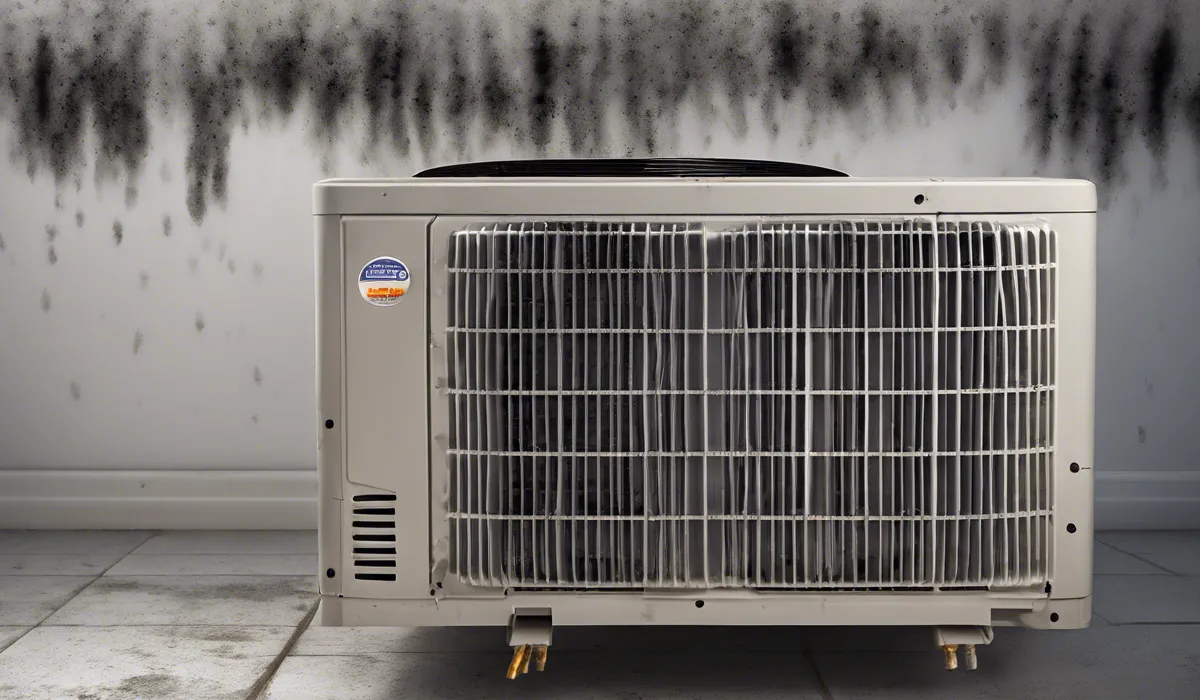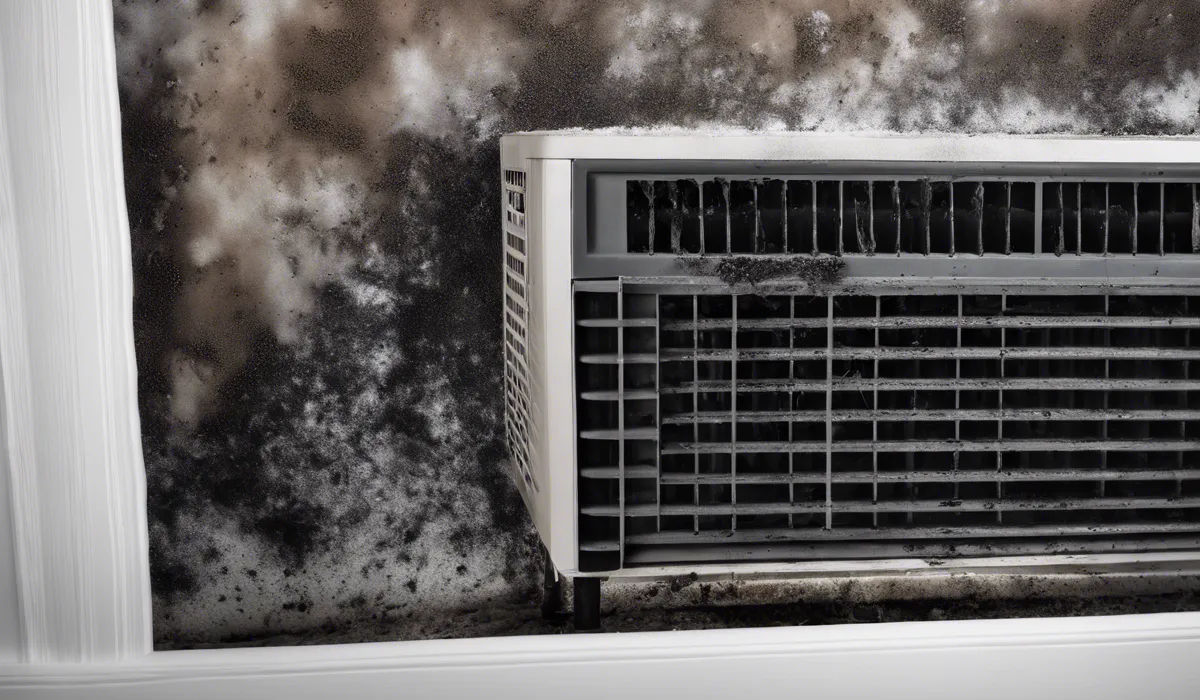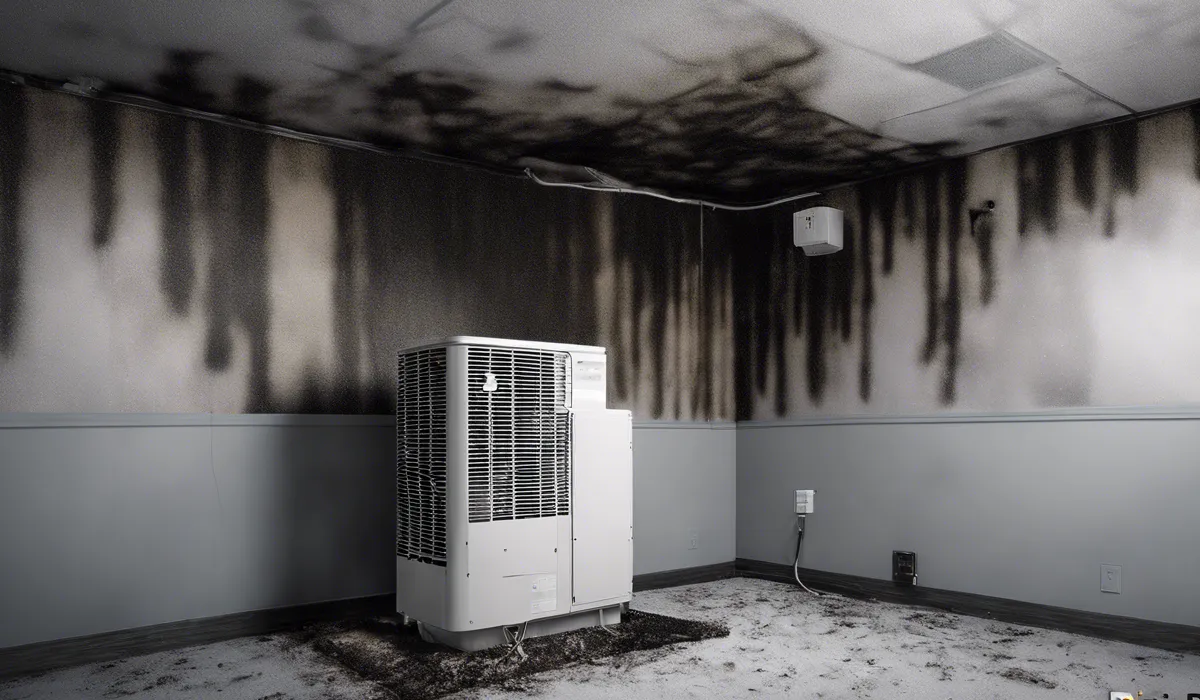Black mold in an AC unit is dangerous as it can release spores into the air, potentially causing respiratory issues and allergic reactions.
It’s important to remove the mold promptly and thoroughly clean the AC unit to ensure indoor air quality and prevent health risks.
Understanding Black Mold in AC Units

Definition of Black Mold (Stachybotrys chartarum)
Black mold, scientifically known as Stachybotrys chartarum, is a type of fungus that thrives in damp, warm, and humid conditions.
This mold is greenish-black in color and can appear slimy when it accumulates moisture. It’s notorious for its potential to release mycotoxins, which are harmful substances that can affect human health.
How Black Mold Develops in AC Units?
AC units can provide an ideal environment for black mold to grow. The presence of condensation, organic material, and stagnant air in parts of the system such as drip pans, coils, and ducts create perfect conditions for mold spores to settle and multiply.
Environmental Conditions that Promote Mold Growth
Black mold flourishes in environments with high humidity levels, poor ventilation, and temperatures that are generally between 68 to 86 degrees Fahrenheit.
When these conditions are met, the spores can germinate and the mold colony can grow within 24 to 48 hours.
Common Signs of Black Mold in AC Systems
Signs of black mold in AC units include a musty smell, visible mold growth around air ducts, vents, or drip pans, and a noticeable decline in air quality. If you experience these symptoms, it is crucial to inspect your AC system for mold.
Health Risks Associated with Black Mold Exposure

Immediate Health Effects of Black Mold Exposure
Exposure to black mold can cause various symptoms such as coughing, sneezing, throat irritation, and skin rashes.
Some individuals may experience more severe reactions, including shortness of breath or the development of asthma-like symptoms.
Long-term Health Risks for Sensitive Individuals
People with compromised immune systems, the elderly, and young children are particularly sensitive to black mold.
Long-term exposure can lead to more serious conditions such as chronic respiratory illness and persistent allergies.
Specific Health Concerns for People with Respiratory Conditions
Individuals with pre-existing respiratory conditions such as asthma or chronic obstructive pulmonary disease (COPD) may find their symptoms worsened by exposure to black mold. It can trigger attacks and further lower lung function.
Black Mold’s Impact on Indoor Air Quality and Overall Well-being
Poor indoor air quality caused by black mold can lead to discomfort and a decline in quality of life.
Consistent exposure may contribute to long-term health issues and affect mental health, causing conditions such as insomnia and depression.
Prevention and Remediation Strategies

Regular Maintenance and Cleaning Tips for AC Units
Keeping your AC unit clean and well-maintained is essential to prevent mold growth. This includes regularly replacing filters, cleaning drip pans, and ensuring that all components are dry and free from debris.
Importance of Humidity Control and Proper Ventilation
Controlling humidity levels within your home, ideally between 30 to 50 percent, can significantly deter mold growth.
Proper ventilation, especially in areas like the bathroom and kitchen, helps to reduce moisture and keep the air moving.
Professional Mold Assessment and Removal Processes
If you suspect a serious mold issue, it’s best to contact professionals who can assess the situation accurately.
They have the tools and expertise to safely remove mold from your AC unit and home.
Guidelines for Safe DIY Mold Cleaning (If Applicable)
For minor mold problems, you can clean your AC unit using water and detergent. However, it’s important to wear protective gear and ensure the area is well-ventilated during the process.
Preventative Measures to Keep Black Mold from Returning
After cleaning, prevent mold from returning by keeping the AC unit and surrounding areas dry, using air purifiers, and periodically checking for any signs of moisture or mold growth.
To ensure that black mold does not compromise your home’s air quality and your health, adopting these strategies is crucial.
Regularly maintaining your AC unit not only prevents mold but also improves its efficiency, which can be as crucial as ensuring the right size bolts for a toilet flange in a plumbing system.
Like the intricate details that go into selecting the appropriate what size binoculars for birding, attention to detail in preventing mold growth can greatly enhance your living environment.
Additionally, understanding the subtleties of mold prevention can be as specific as knowing the right what size braid for a 2500 reel during a fishing trip, emphasizing that precision and proper care can lead to the best outcomes.
FAQs About Black Mold in AC Units
Is black mold in an AC unit dangerous to health?
Yes, black mold in an AC unit is considered dangerous as it can release spores into the air, which may cause respiratory issues and allergic reactions when inhaled.
What are the risks of inhaling spores from black mold in an AC unit?
Inhaling spores from black mold can lead to health problems such as coughing, wheezing, nasal congestion, eye irritation, and in severe cases, can exacerbate asthma and other respiratory conditions.
How should you clean black mold from an AC unit?
To clean black mold from an AC unit, it’s important to wear protective gear, use a cleaner designed for mold removal, and thoroughly clean or replace any contaminated parts of the AC unit.
Can black mold in an AC unit spread throughout the home?
Yes, black mold in an AC unit can spread throughout the home as the unit circulates air, distributing mold spores to different rooms and surfaces.
Is it safe to stay in a home with black mold in the AC unit?
It is not recommended to stay in a home with black mold in the AC unit as it can adversely affect indoor air quality and potentially lead to health risks, especially for individuals with allergies or respiratory conditions.
Final Thoughts
Black mold in AC units poses a significant health risk by dispersing spores that can lead to respiratory problems and allergic reactions.
Ensuring the prompt removal and thorough cleaning of mold from air conditioning systems is crucial for maintaining indoor air quality and safeguarding against potential health hazards.
